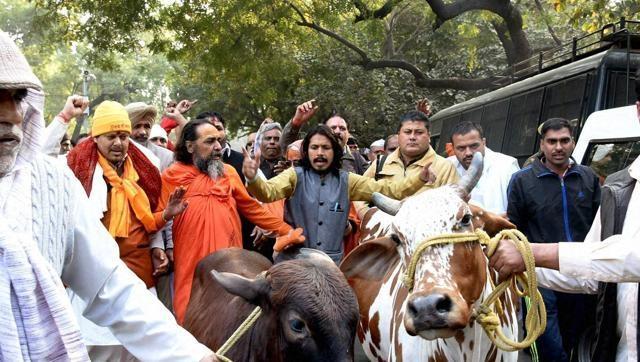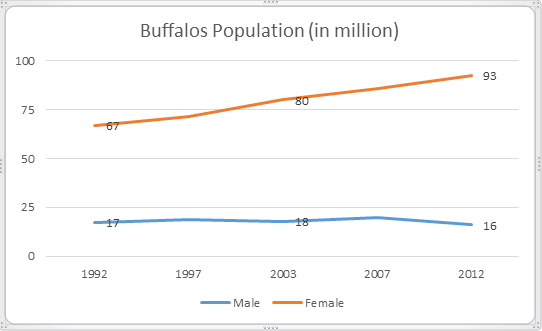Gaurakshaks are Anti-Farmer

If we are to believe the propaganda of the BJP and Sangh Parivar – the cattle* of India are on the verge of extinction. The blame for this imminent extinction, is laid at the door of those who consume and sell bovine** meat – mainly Muslims. Equally blamed are the slaughter houses from where, apparently, beef is being exported on a massive scale, threatening the survival of the species.
Armed with these claims, the BJP has been promoting hysteria among its supporters against minorities and dalits, who are involved in transportation of cattle. Propelled by their ‘love’ for the mother cow, self-proclaimed ‘gau-rakshaks’ frequently beat up and lynch Muslims and Dalits with tacit support from the police. Prime Minister Modi adds fuel to this fire, by frequently alluding to ‘the pink revolution’ - referring to beef consumption and exports.
What are the facts? Is India’s cattle at risk due to beef consumption or export?
While it is true that, India’s bovine meat (buffalo and cattle meat) exports have been increasing over the years - It has not caused any decrease in India’s bovine (cattle and buffalo) population. In fact, India’s bovine population has increased – from 2.89 crore to 3 crore (1992 to 2012), as has per capita milk production, from 55 million tonnes to 155 million tonnes (1992 – 2016).

data source: Department of Animal Husbandry, Dairying & Fisheries, Ministry of Agriculture, GoI
Within the total bovine population, the number of buffalos has been steadily increasing , while the number of cattle (cows and bullocks) has declined. Considering that buffalo meat is also exported despite which their number has been increasing, meat exports alone can not be the reason for the decline in the cattle population.

If we look closer, we see that with in the cattle population - the number of cows (female cattle) has not declined at all, but rising steadily – from 1.03 crore to 1.23 crore (1992 and 2012). It is the steep fall in the number of bullocks from 1.02 crore to 0.68 crore – which is the reason behind the fall in the cattle population. If the increase in demand for the beef is the reason for declining cattle numbers, then it should have effected the cow population as well, which clearly is not the case. What is the reason for decline in the number of bullocks?

Traditionally in the rural areas, cows and bullocks were equally preferred – the former for milk and the later as draught animals. So, we see that in 1992, the number of cows and bullocks was more or less equal. But, in the case of buffalos, only the females were preferred by the farmers. Since male buffalos are of no great use as draught animals, farmers usually sold them to slaughter houses. This is clear from the fact that number of female buffalos has always been 4 to 5 times more than that of the male buffalos. Today, similar trend is seen in the cattle population as well, with the bullock population declining to half that of the cows, in the last 25 years.
The advent of green revolution and the subsequent mechanisation of agricultural operations has increasingly made the bullock redundant in rural areas. Various agricultural operations - ploughing, levelling, transportation of agricultural product etc., which have been performed with bullocks – are today being performed by the tractors. So, just like the male buffalo, bullock too has very little role to play in today’s agriculture, resulting in decline of it’s numbers.
The bullock still plays the role of a buffer for the farmer during droughts. For a small farmer, sale of his cattle, particularly the bullocks, is like an insurance during the drought years. He call sell it in the market during a drought.
The cow vigilantes, with beating up and killing those who sell and purchase cattle, are in fact hurting the small farmer, who is central to the cattle economy. In drought hit regions, one of which is the BJP ruled Mahararshtra, the cow vigilantism has led to a fall in cattle prices, causing a great distress to farmers, who are unable to sell their cattle.
The truth is that in India the livestock economy has been doing well, providing a much needed additional source of income for the small farmer. Per capita milk production has been steadily increasing, as has the meat production. These have been accompanied by a rise in the bovine population. But, the repeated attacks of gau-rakshaks on farmers, cattle traders, slaughter houses and meat consumer are going to damage the livelihoods of small famers. The vigilantism, will force the farmers to retain unproductive animals – resulting in considerable increase in the costs of maintaining live stock. India’s small peasant, who is already suffering under frequent droughts and large debts, will be pushed to the brink, thanks to the saffron government’s cattle politics.
* Bullocks and Cows
** In this article bovine means only cows, bullocks, and buffalos
Disclaimer: The views expressed here are the author's personal views, and do not necessarily represent the views of Newsclick.
Get the latest reports & analysis with people's perspective on Protests, movements & deep analytical videos, discussions of the current affairs in your Telegram app. Subscribe to NewsClick's Telegram channel & get Real-Time updates on stories, as they get published on our website.
























